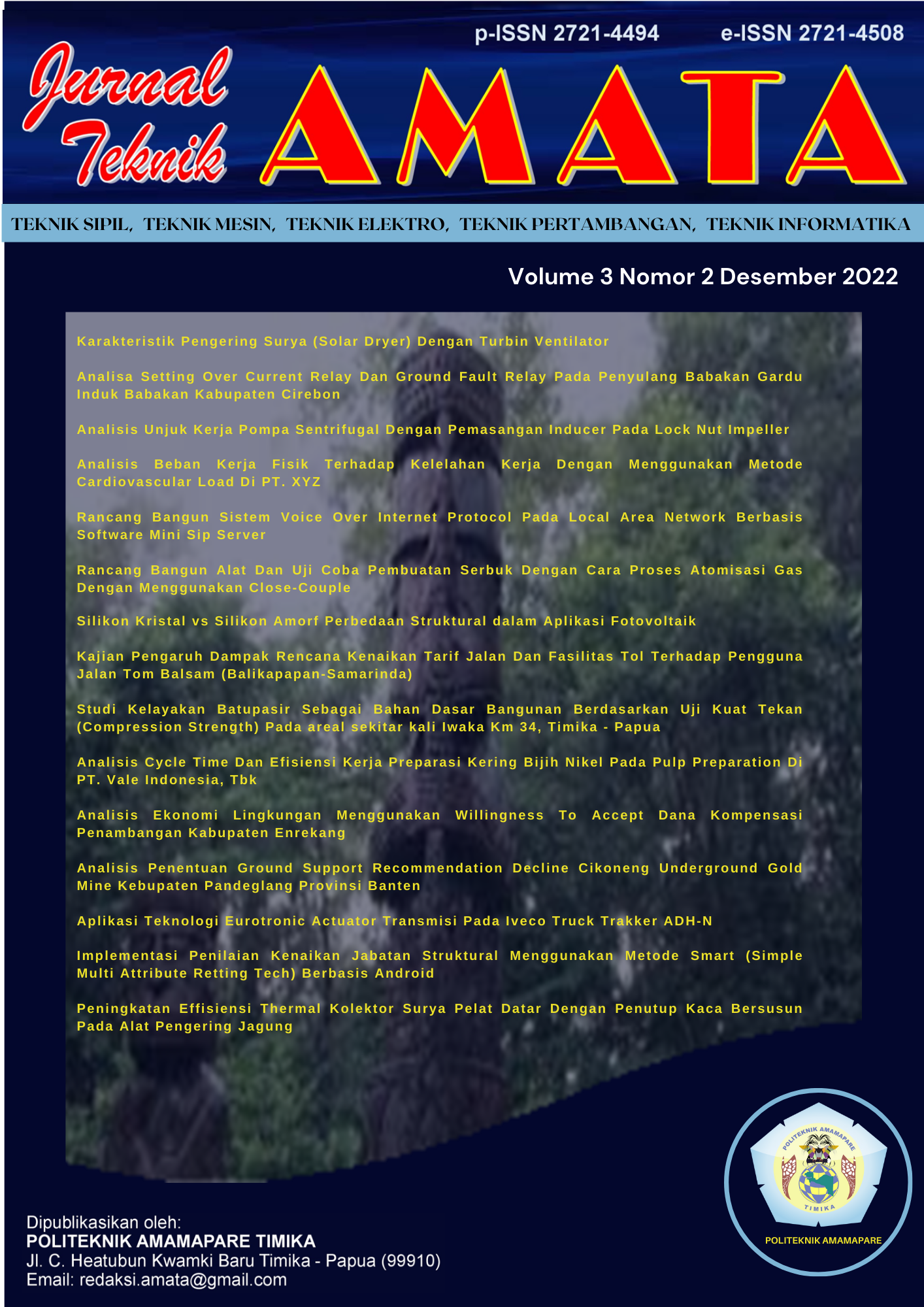Silikon Kristal vs Silikon Amorf Perbedaan Struktural dalam Aplikasi Fotovoltaik
DOI:
https://doi.org/10.55334/jtam.v3i2.303Abstract
Pada studi ini, kami melaporkan secara singkat tentang struktur silikon kristal, silikon amorf, dan silikon amorf
terhidrogenasi dalam menyoroti perbedaan struktural. Kemudian, pada bagian struktur ini kami menyajikan
perbandingan berbasis fitur-demi-fitur antara sel surya c-Si dan sel surya a-Si. Bagaimana peran struktur silikon
yang berbeda dalam setiap karakteristik PV selanjutnya dieksplorasi. Pada akhirnya, berdasarkan fitur-fitur yang
dianalisis sebelumnya, kami melakukkan pembahasan lebih lanjut tentang keadaan di mana penggunaan sel surya
c-Si atau a-Si. Singkatnya, efisiensi konversi yang luar biasa dan biaya yang ramah pengguna sel surya silikon
kristalin terbukti berhasil, sementara sifat mengganggu sel surya silikon amorf menunjukkan beberapa sifat optik
dan listrik, seperti koefisien penyerapan tinggi dan Efek Staebler-Wronski, yang belum pernah diantisipasi
sebelumnya.
Downloads
References
Baskar, Sam, and R. Pratibha Nalini. 2016.
“Synthesis and Characterization of
Silicon Nanocrystals in SiC Matrix
Using Sputtering and PECVD
Techniques.” Materials Today:
Proceedings 3(6): 2121–31.
Cahyono, Yoyok et al. 2017. “Efek StaeblerWronski
Dan Pengaruh Waktu Anil
Pada Lapisan Instrinsik Silikon Amorf
Terhidrogenasi (a-Si:H).” Jurnal Fisika
dan Aplikasinya 13(2): 59–62.
Chittick, R. C., J. H. Alexander, and H. F.
Sterling. 1969. “The Preparation and
Properties of Amorphous Silicon.”
Journal of The Electrochemical Society
(1): 77.
Despotou, E. 2012. “1.10 - Vision for
Photovoltaics in the Future.” In
Comprehensive Renewable Energy, ed.
Ali Sayigh. Oxford: Elsevier, 179–98.
Flewitt, A. J. 2012. “Hydrogenated Amorphous
Silicon Thin Film Transistors (a Si:H
TFTs).” In Handbook of Visual Display
Technology, eds. Janglin Chen, Wayne
Cranton, and Mark Fihn. Berlin,
Heidelberg: Springer, 627–46..
Fonash, Stephen J. 2010. “Chapter Three -
Structures, Materials, and Scale.” In
Solar Cell Device Physics (Second
Edition), ed. Stephen J. Fonash. Boston:
Academic Press, 67–120.
Guo-gang, Qin, and Kong Guang-lin. 1988. “A
New Model for the Staebler–Wronski
Effect.” Philosophical Magazine Letters
(2): 117–22.
Hamdani, Dadan et al. 2022. “The Effects of
Dopant Concentration on
the
Performances of the A-SiOx:H(p)/aSi:H(I1)/a-Si:H(I2)/Μc-Si:H(n)
Heterojunction
Solar
Cell.”
International Journal of Renewable
Energy Development 11(1): 173–81.
Illiberi, A. et al. 2011. “Effect of Ion
Bombardment on the A-Si:H Based
Surface Passivation of c-Si Surfaces.”
Applied Physics Letters 98(24): 242115.
Irvine, Stuart. 2007. “Solar Cells and
Photovoltaics.” In Springer Handbook
of Electronic and Photonic Materials,
Springer Handbooks, eds. Safa Kasap
and Peter Capper. Boston, MA: Springer
US, 1095–1106.
Kasap, Safa et al. 2007. “Optical Properties of
Electronic Materials: Fundamentals and
Characterization.”
In
Springer
Handbook of Electronic and Photonic
Materials, Springer Handbooks, eds.
Safa Kasap and Peter Capper. Boston,
MA: Springer US, 47–77.
Krenckel, Patricia et al. 2021. “Propagation of
Crystal Defects during Directional
Solidification of Silicon via Induction of
Functional Defects.” Crystals 11(2): 90.
Prayogi, Soni et al. 2021. “The Effect of Adding
an Active Layer to the Structure of ASi:
H Solar Cells on the Efficiency
Using RF-PECVD.” Journal of
Materials Science: Materials
in
Electronics 32(6): 7609–18.
Prayogi, Soni, Yoyok Cahyono, and D.
Darminto. 2022. “Electronic Structure
Analysis of A-Si: H p-I1-I2-n Solar
Cells Using
Ellipsometry
Prayogi, Soni, Yoyok Cahyono, Dadan
Hamdani, and Darminto. 2022. “Effect
of Active Layer Thickness on the
Performance
of Amorphous
Hydrogenated Silicon Solar Cells.”
Engineering and Applied Science
Research 49(2): 201–8.
Ren, Ningyu et al. 2018. “Controlling
Performance of A-Si:H Solar Cell with
SnO2:F Front Electrode by Introducing
Dual p-Layers with p-a-SiOx:H/p-NcSiOx:H
Nanostructure.” Solar Energy
: 907–13.
“Renewables 2019 – Analysis.” IEA.
https://www.iea.org/reports/renewables2019
(November
,
.
Schulze, T. F. et al. 2010. “Impact of A-Si:H
Structural Properties on the Annealing
Behavior
of
a-Si:H/c-Si
Heterostructures Used as Precursors for
High-Efficiency Solar Cells.” MRS
Online Proceedings Library 1268(1):
Sundaram, Senthilarasu, David Benson, and
Tapas Kumar Mallick. 2016. “Chapter 2
- Overview of the PV Industry and
Different Technologies.” In Solar
Photovoltaic Technology Production,
eds. Senthilarasu Sundaram, David
Benson, and Tapas Kumar Mallick.
Academic Press, 7–22.
Tuttle, Blair R. 2018. “Dangling Bond Defects
in SiC: An Ab Initio Study.” Physical
Review B 97(4): 045203.
Welser, Roger E. et al. 2019. “Design and
Demonstration of High-Efficiency
Quantum Well Solar Cells Employing
Thin Strained Superlattices.” Scientific
Reports 9(1): 13955.
Zhao, Lei et al. 2017. “Plasma Enhanced
Chemical Vapor Deposition of
Excellent A-Si:H Passivation Layers for
a-Si:H/c-Si Heterojunction Solar Cells
at High Pressure and High Power.”
Frontiers in Energy 11(1): 85–91.
Downloads
Published
Issue
Section
License
Copyright (c) 2022 Jurnal Teknik AMATA

This work is licensed under a Creative Commons Attribution 4.0 International License.













